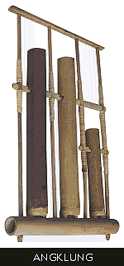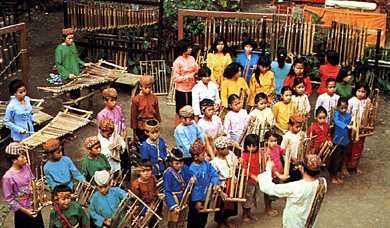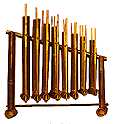![]() The following
description courtesy of Percussive Notes, April, 1998.
The following
description courtesy of Percussive Notes, April, 1998.
An official publication of:
The Percussive Arts Society,
701 NW Ferris Avenue, Lawton, OK.
|
| Angklung are shaken idiophonic* instruments
native to Indonesia. Traditionally, large numbers of them are shaken for ceremonial
dances. They can also be played by a group of musicians, each of whom has one instrument
of differing pitch in each hand. The entire group performs a single melody in much the
same way as a handbell choir, with each performer shaking an angklung at the appropriate
time in the melody. *Idiophones are instruments made of naturally sonorous
material, sounded in a variety of different ways: stamping, stamped, shaken, percussion,
concussion, friction, scraped, and plucked.
|
 Each angklung consists of two or three bamboo
tubes of differing lengths tuned in octaves. The tubes are mounted in a frame so that a
slot on each tube aligns into a cross-piece that strikes the tube when the instrument is
shaken. Carl Orff included unpitched angklung in his "Catulli Carmina" and
"Weihnachtsspiel," and scored "Prometheus" for two angklung pitched in
G-flat and B-flat. Each angklung consists of two or three bamboo
tubes of differing lengths tuned in octaves. The tubes are mounted in a frame so that a
slot on each tube aligns into a cross-piece that strikes the tube when the instrument is
shaken. Carl Orff included unpitched angklung in his "Catulli Carmina" and
"Weihnachtsspiel," and scored "Prometheus" for two angklung pitched in
G-flat and B-flat.
|
| In the early 20th century, J.C. Deagan
developed an American version, called Organ Chimes or Aluminum Chimes, constructed from
metal. When mounted on a rack, which allowed one or two people to perform solo pieces,
Deagan's Organ Chimes became a popular novelty instrument for vaudeville and radio shows.
|
Please click on the links below for more on the angklung:
|


